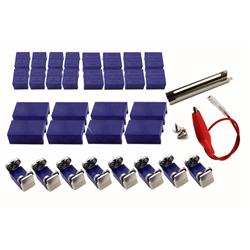Static grass puffer bottles work by manually charging model grass fibres with static electricity. When the charged...
No products
Product successfully added to your shopping cart
There are 0 items in your cart. There is 1 item in your cart.
Search Tips
Should I run in a brand new model railway locomotive?
Yes, it is recommended to run in a brand-new model railway locomotive before regular use. Running in helps to ensure that the moving parts are properly lubricated and that the motor has a chance to settle into its operating range. It's important to follow the manufacturer's instructions for running in, as different models may have different requirements. Additionally, it is recommended to take it slowly and make gradually increasing speed tests, this is to check the locomotive is functioning properly and to make any necessary adjustments before regular use.
Here are some steps to follow to run in a new model railway locomotive:
Start with a slow speed test: Begin by running the locomotive at a slow speed for a few minutes, then stop it and check for any unusual sounds or vibrations.
Gradually increase speed: Slowly increase the speed of the locomotive and keep an eye out for any issues. It is important to avoid putting too much strain on the motor and gears during the run-in period.
Check the direction of travel: Make sure the locomotive is running in the correct direction. Some models may have specific requirements for running in and may need to be run in a particular direction to prevent damage to the gears.
Pay attention to sounds and performance: Observe any unusual sounds or vibrations and be mindful of the locomotive's performance. If anything out of the ordinary is observed, then the locomotive should be stopped and investigated to identify the issue.
Repeat the process: Repeat the process of gradually increasing the speed until the recommended run-in period has been completed.
It is important to follow the manufacturer's instructions for running in a model railway locomotive, as different models may have different requirements. Additionally, it is a good idea to keep records of the running in process so that they can be referred to in the future.
Click here to receive the tips weekly in your mailbox. You can unsubscribe at any time.










